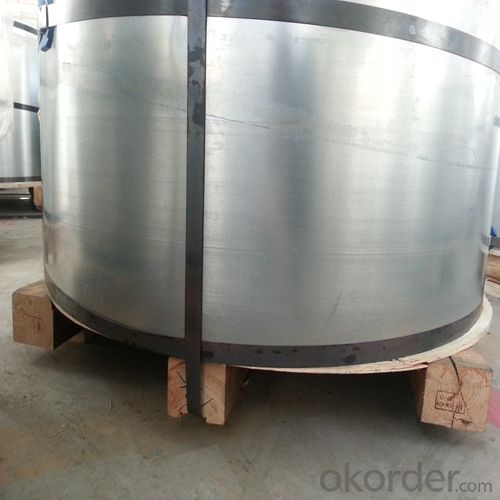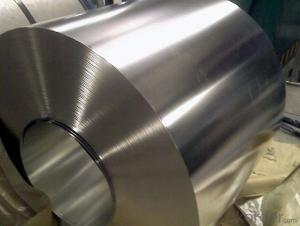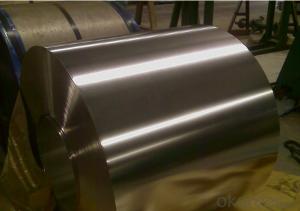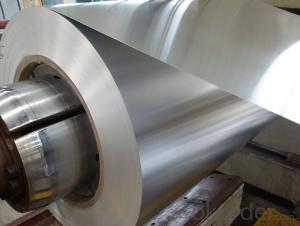Electrolytic Tinplate Sheets and Coils of Food Package Use
- Loading Port:
- Qingdao
- Payment Terms:
- TT OR LC
- Min Order Qty:
- 25 m.t.
- Supply Capability:
- 30000 m.t./month
OKorder Service Pledge
OKorder Financial Service
You Might Also Like
1.Structure of Electrolytic Tinplate Sheets and Coils of Food Package Use Description
Electrolytic Tinplate is a thin steel sheet coated by tin. It has an extremely beautiful metallic luster as well as excellent properties in corrosion resistance, solder ability, and weld ability.
2.Main Features of the Electrolytic Tinplate Sheets and Coils of Food Package Use
Electrolytic Tinplate undoubtedly enjoys the pride of place as a packaging medium especially for food. It owes its unique position to its "nine layer sandwich structure", each of which contributes to its eminence as a packing material. The steel base of electrolytic tinplate provides the necessary strength and formability for can fabrication. The tin-iron alloy layer provides the bond between the steel and free tin layer. The free tin layer is not only responsible for the attractive bright finish and ease of solderability but is also non-toxic- a factor of vital importance in food packaging!
Tinplate is also widely used for making all types of containers such as food cans, beverage cans, and artistic cans, tea cans, painting cans, chemical package cans and dry food package cans, metal printing etc. Its applications are not limited to containers; recently, electrolytic tinplate has also been used for making electrical machinery parts and many other products.
3.Electrolytic Tinplate Sheets and Coils of Food Package Use Images



4.Electrolytic Tinplate Sheets and Coils of Food Package Use Specification
Standard:JIS G3303
Material: MR
Thickness:0.35mm
Width: 750
Temper: T3
Annealing: BA
Coil Inner Diameter: 508mm
Weight: 7 tons/coil
Passivation:311
Oil: DOS
Surface: Finish,bright,
5.FAQ of Electrolytic Tinplate Sheets and Coils of Food Package Use
1. What is the delivery time for your prime quality tinplate?
Usually 35 days after order confirmation.
2. What is your Minimum Order Quantity?
Usually MOQ is 50tons for one single size, for trial order, it can be 25 tons.
3. What is the payment term?
The most common we use is L/C at sight or TT. We can also try use other terms.
- Q: What are the main properties of tinplate?
- Tinplate is a type of steel coated with a thin layer of tin, providing it with several key properties. It is highly corrosion-resistant, making it suitable for packaging food and beverages. It also has excellent solderability, allowing for easy joining and sealing of tinplate cans. Additionally, tinplate has good formability, enabling it to be shaped into various container forms. Lastly, its aesthetic appeal and the ability to print on its surface make it an ideal choice for attractive packaging designs.
- Q: A tin rust problem for help
- The rusty cans, the best prevention is to use empty cans of good quality, ensure the tank, the outer wall of the antirust paint, coating thickness and curing degree basically no problem, pay special attention to the weld coating is complete. Choosing a good supplier and improving the inspection of empty cans are very important.
- Q: How does tinplate contribute to the protection of textile products?
- Tinplate contributes to the protection of textile products by providing a durable and corrosion-resistant packaging material. It acts as a barrier against moisture, oxygen, and other environmental factors that could damage the textiles. Additionally, tinplate containers can be sealed tightly, ensuring that the textile products remain intact and free from contamination during storage and transportation.
- Q: How does tinplate affect the recyclability of mixed-material packaging?
- Tinplate can have a positive impact on the recyclability of mixed-material packaging. Tinplate is highly recyclable and can be easily separated from other materials during the recycling process. This allows for efficient recycling of tinplate components in mixed-material packaging, contributing to overall sustainability efforts.
- Q: Can tinplate be used for packaging petrochemical products?
- Yes, tinplate can be used for packaging petrochemical products. Tinplate is a type of steel coated with a thin layer of tin, providing it with excellent corrosion resistance and durability. These properties make it suitable for packaging various products, including petrochemicals, as it can protect the contents from external factors such as moisture and oxygen. Additionally, tinplate cans can be sealed tightly, ensuring the safety and integrity of the petrochemical products during storage and transportation.
- Q: What are the main applications of tinplate in the stationery industry?
- Tinplate is commonly used in the stationery industry for various purposes such as making pencil boxes, pen holders, and storage containers. Its durability, lightweight nature, and ability to be molded into different shapes make it ideal for creating functional and aesthetically pleasing stationery products. Additionally, tinplate's ability to resist moisture and protect its contents from damage makes it a preferred choice for items like pencil sharpeners and paper clips.
- Q: What are the typical production volumes for tinplate?
- The typical production volumes for tinplate vary depending on market demand and specific manufacturing capabilities. However, on a global scale, millions of metric tons of tinplate are produced each year to meet the needs of various industries such as packaging, automotive, electronics, and construction.
- Q: What are the main factors influencing the supply of tinplate?
- The main factors influencing the supply of tinplate are the availability and cost of raw materials such as tin, steel, and other alloys, the production capacity and efficiency of tinplate manufacturers, government regulations and policies, fluctuations in demand from industries such as packaging, automotive, and electronics, and global economic conditions and trade dynamics.
- Q: How does tinplate packaging contribute to product aesthetics?
- Tinplate packaging contributes to product aesthetics by offering a visually appealing and versatile option for packaging. Its shiny and reflective surface adds a premium and luxurious look to products, enhancing their overall aesthetic appeal. Additionally, tinplate packaging can be easily customized through various printing techniques, enabling brands to create eye-catching designs, logos, and graphics that attract consumers' attention on store shelves. Its durability and ability to maintain color and shape also ensure that the product's aesthetic appeal remains intact throughout its lifespan.
- Q: What are the different closure options for tinplate packaging?
- The different closure options for tinplate packaging include twist-off caps, lug caps, screw caps, and press-on caps.
Send your message to us
Electrolytic Tinplate Sheets and Coils of Food Package Use
- Loading Port:
- Qingdao
- Payment Terms:
- TT OR LC
- Min Order Qty:
- 25 m.t.
- Supply Capability:
- 30000 m.t./month
OKorder Service Pledge
OKorder Financial Service
Similar products
Hot products
Hot Searches
Related keywords



























